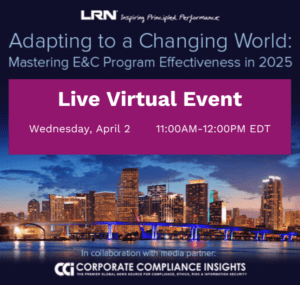Organizational blind spots often result from a dysfunctional culture. Once the executive team and board are aware of them, what should they do to address them? Protiviti’s Jim DeLoach offers guidance for this important process.
At the beginning of the movie “The Big Short,” a quotation apocryphally attributed to Mark Twain appears: “It ain’t what you don’t know that gets you into trouble. It’s what you know for sure that just ain’t so.”
The quote perfectly sets the premise of the movie’s narrative about how the 2007-08 financial crisis was triggered by the U.S. housing bubble. Though the iconic American humorist never actually said it, the quote works in the film on one level to set the tone for a discussion of the housing crisis, and it works on a meta level, given that Twain is the frequent subject of misquotations. It also captures the danger of organizational blind spots in business.
In these pages, I recently defined a blind spot as something pertinent to an organization’s viability that the board and the C-suite have not focused on at all or enough. In this context, blind spots include significant matters of which leaders either are not aware or have chosen to de-emphasize or ignore. Blind spots may very well occur because of cognitive biases that cloud leaders’ assessments of markets, customer preferences, operations and corporate culture in such a manner that they end up believing a particular reality exists when it does not — exactly what Mr. Twain was talking about, or rather, what he wasn’t actually talking about.
Organizations need to take several steps to manage the risk of blind spots.
Board Game: 3 Important Questions About Composition & Culture
Boards need culture in which fiduciary responsibility can thrive
Read moreDetailsIdentify them
Given the sources of blind spots, senior leaders and their boards can take a number of important steps to identify them.
For the board of directors:
- Assess whether current board culture, composition and agendas are fit for purpose in the current disruptive business environment.
- Hold effective executive sessions without management present and with specific company executives.
- Conduct a periodic self-assessment of the performance of and collaboration among the full board, its designated committees and individual board members.
- Assess the quality of the board’s discussions with management.
- Determine whether board education is adequate, relevant and timely.
For senior executives:
- Request an objective culture assessment seeking confidential feedback from all levels of the organization, and report the unvarnished results to the executive team and board.
- Obtain intelligence briefings on industry, competitor and technology trends as well as feedback from customers.
- Assess the quality of the intelligence feeds into the company’s strategy-setting process.
- Encourage customer advisory teams, knowledgeable subject-matter experts and field operators to challenge key assumptions and provide fresh insights.
- Implement an effective risk management framework to foster the identification, sourcing, measurement, monitoring and mitigation of risk, and integrate that framework with the strategy-setting and performance management processes.
For both senior executives and directors:
- Seek input and feedback from analysts, investment bankers, rating agencies, startups and suppliers and other external partners that are part of the value ecosystem, as well as from think tanks, media outlets and external advisers.
- Evaluate the quality, timeliness and relevance of the information used in C-suite and boardroom discussions, and contrast that information with multiple, credible sources to identify patterns, discrepancies and implications.
- Foster and encourage diverse and expert perspectives in the C-suite and in boardrooms.
- Regularly update and revise understanding of markets and the competitive environment with data from governments, central banks, international organizations, industry associations, independent and reputable research firms, and other intelligence sources.
- Make more effective use of internal audit, particularly with respect to culture.
The above steps are intended to be illustrative. They can help reduce the risk of groupthink, confirmation bias, misinformation, complacency, surprise and the narrow thinking that misses the big picture, all of which contribute to organizational blind spots.
Be mindful of red flags
Red flags are useful, as they can offer an early warning or an indicator of the possibility of blind spots. Executives and directors should watch for red flags that indicate the possible existence of blind spots. The table below provides illustrative examples in three groups — behavioral, strategic and operational:
| Behavioral | Strategic | Operational |
| “Everything is great” is heard too often. | Management is playing out a strategy not aligned with market realities. | The board has not refreshed its membership to keep pace with changes in the business environment and the company’s strategic profile. |
| Too much looking back and not enough looking forward occurs. | Management resists altering the business model despite compelling evidence that excessive risks are being undertaken to generate current returns. | Ineffective, check-the-box risk management processes and tools prevail. |
| There is organizational resistance to change. | The organization is constantly reactive to market events. | There is a lack of informative dashboards on key topics. |
| The board includes members who are “inactive,” overboarded or not keeping current. | Scenario analysis and stress testing are not applied to evaluate alternative actions and assess response readiness to plausible and extreme scenarios. | Feedback mechanisms for customers and employees are missing. |
| Evidence exists that middle managers are not aligned with the tone at the top. | Effective communication down, up and across the company does not exist. | |
| A lack of diversity in perspectives (e.g., excessive like-mindedness) persists in the boardroom and the C-suite. | Incentive compensation plans are flawed. | |
| Short-termism (e.g., overemphasis on making the numbers) prevails. |
Minimize their impact
If the signs indicate that blind spots exist, actions by the executive team and board depend on facts and circumstances. Following are steps executives and directors can take:
If there is cultural dysfunction, exercise focused attention and decisiveness to correct the issue. Allowing dysfunction to fester as a “white elephant” that people can see but do not take action to address risks talent drain, lasting brand erosion and reputation damage.
Inculcate a resilient organizational mindset that adapts to shifting market realities. Directors and executives should strive toward more agility in the boardroom and C-suite. Companies positioned to pivot quickly understand their most critical strategic assumptions, monitor continued validity of those assumptions over time, use early alerts to trigger timely warning and decisions to address change and build discipline in the culture to act timely before market opportunities and emerging risks become common knowledge in the market. Resilient organizations understand that assumptions are subject to change.
Deploy scenario analysis regularly to look ahead to what may be around the next corner. Anticipating extreme but plausible scenarios and stress-testing base plans against those scenarios provides a discipline that forces “what if” discussions around response plans, action prompts and decision points. Understanding the “pain” of management’s strategic assumptions being rendered invalid due to potential market developments facilitates preparedness for unforeseen events that no one sees coming — even “black swan” events.
Minimize the impact of unconscious bias. When making risk/reward decisions, efforts should be undertaken to reduce the dangers of groupthink. It is not unusual for groups to form opinions or make decisions without having engaged in robust debate or listened to dissenting views. Thus, efforts should be made to ensure that all views are heard from the right sources and considered in the decision-making process.
To that end, it is important to avoid the trappings of beginning with a presumptive conclusion. It also helps to foster diversity of thought, distinguish between divergent and convergent dialogues, accept conflict and devil’s advocacy as the norm, understand why dissenters disagree and seek diverse external perspectives.
This does not mean slowing down the process through endless consensus-building. In the interests of expediency, it may be necessary to disagree and commit to act, and consider the consequences if the decision is wrong. Managing by fact and grounding discussions with a relentless focus on the customer experience helps sharpen the conversation.
Set the tone with sound governance. As leaders keep an eye on relevant market trends, they should build trust within the organization, organize for speed, deploy data-informed approaches to understand customer behavior, incent necessary changes to processes, products and services, and invest in talent that can make the desired behaviors and performance happen. A commitment to core values, preserving brand image, and fostering a diverse, inclusive environment committed to ethical and responsible business behavior are table stakes.
Ask the tough questions. Intellectual curiosity goes a long way in both the C-suite and boardroom. Today’s dynamic times require courageous, collaborative strategic conversations. A proactive and resilient approach to addressing blind spots entails asking questions that explicitly reference their potential existence. Following are examples:
- What blind spots might exist in our current strategic plan, and how can we proactively identify and address them?
- Do we seek feedback from employees, customers, suppliers and other stakeholders to identify potential blind spots in our business model and culture?
- What mechanisms or processes are implemented to periodically assess and audit the effectiveness of our risk management practices in uncovering hidden risks and vulnerabilities?
- Are we using risk assessments and scenario analysis to help us uncover blind spots and develop early warning alerts, action prompts and contingency plans?
- Are we effectively leveraging data analytics and emerging technologies to uncover blind spots with respect to our operations, the customer experience or market trends?
- How can we continuously educate ourselves and stay updated on industry trends, emerging technologies, geopolitical developments, and potential blind spots that may arise in the future?
Again, the above suggestions are by no means exhaustive. Managing the risk of blind spots — what we should know but don’t — depends on facts and circumstances. In the end, it is about collaboration, trust, transparency and remaining in touch with changing market realities. A focus on identifying and managing the impact of blind spots can enhance the organization’s strategy, business model, culture and decision-making.




 Jim DeLoach, a founding
Jim DeLoach, a founding 









